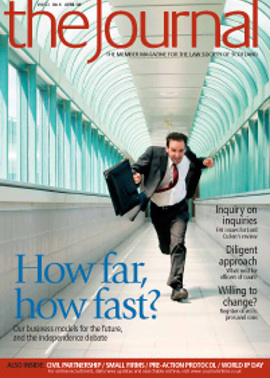Heads above water

2005 was a year of considerable change for many firms with the withdrawal of the Table of Fees and the introduction of the new Client Communication Practice Rules. A basic element of practice – the calculation of fees – changed and life became very much more complicated. 2006 is likely to see further change with the Scottish version of Clementi and the potential for increased competition it is likely to bring over the coming years.
In these times of change and uncertainty, effective practice management becomes ever more important and as always the annual Law Society of Scotland survey is a valuable tool available to help firms become more successful.
In 2005 a large number of firms once again participated in the survey – 277 firms – representing just under a quarter of all firms, and generating total fees of £274m. Participants will, as previously, receive a detailed report of the survey findings together with a customised report for their firm. This, the first of two articles, discusses three simple calculations that will help firms understand the economics of their business.
1. Hourly expense rates for your firm
Many firms participate each year in the survey – 63% had taken part in 2004 and 55% in each of the previous three years. Many of these firms will focus on the key performance benchmarks and it is very likely that they have outperformed the profession as a whole as a result. Of the new firms that took part this year, it is likely that one of the main motivators was the need to ascertain an indication of the hourly expense rates achieved by themselves and other comparable firms.
The new regime for fees requires firms to become more sophisticated at estimating and billing. They also need a better understanding of what a piece of work has cost. Not all fees will be based on time – other factors also come into play – but some will be. In these cases firms will need to calculate hourly chargeout rates and be able to estimate how long something may take to complete. In order to work out what something has cost, firms will need to calculate hourly expense rates. An article in the June 2005 Journal set out an approach to time costing based on the Society’s methodology, and a very useful letter by Stewart Mullan in August’s Journal developed the issues further.
The survey analyses the average hourly expense rates by level of fee earner, size of firm and location as summarised in tables 1 and 2 above.
The rates in the tables are based on each firm’s overheads and salaries, together with an allowance of £59,500 for each profit-sharing partner. This was the average profit for each profit-sharing partner (after pension provision of 17.5% of salary and a return on working capital). This was the corresponding median figure from the 2004 survey.
It should be noted these rates are not chargeout rates, and firms will add an amount to these in order to arrive at a chargeout rate. A partner’s expense rate may be £135 an hour, but he or she may charge out at, probably, a much higher level.
Understanding your firm’s expense rates is a good starting point in setting chargeout rates. The June article illustrated how firms might undertake these calculations for themselves, and table 3 shows the final calculations.
For the firm in table 3, the partners’ expense rate was £132 an hour, very close to the average for firms in the survey.
2. The minimum fees required of one of your teams
In the firm illustrated in table 3, Michael and Linda work as a small team, supported by two secretaries – one full time and one part time. Total salaries and overheads are £465,700 (£232,850 x 2), including central staff of £61,000 and non-salary overheads (rent, postage etc) of £225,000. The firm has seven fee earners in all. Table 4 calculates the total cost of their team and the minimum level of fees needed to break even.
Fees of £176,500 merely cover the costs of the team. Although they recover some fixed expenses, at that level it would be hard to justify the team’s survival. They will be using desk space that could be more profitably used and will be a drain on the firm’s working capital. If it is assumed that the two solicitors will each bill 1,200 hours in the year, and that their chargeout rates are both £105 an hour, the team could generate fees of £252,000, and a profit of £75,000.
This type of calculation – leaving out the detail of salaries – is one that could usefully be explained to the members of a team, so that everyone understands the economics of the business. It may well have the effect of increasing motivation and could even be linked to a team bonus scheme.
3. The level of fees that needs to be charged daily to break even
As a final thought, what does it cost to open the front door each day? What is the minimum level of fees that the firm needs to charge each day, just to break even?
In the example, the firm’s overheads were £225,000, and the total payroll (employed fee earners and non-fee earners, plus NIC) was £264,000 – a total of £489,000. Working on the basis of 52 weeks in the year, five days a week, less 10 days or so when the office is not open because of public holidays, there are around 250 days a year when the office is open. The amount of fees that needs to be billed each day is just under £2,000. Anything over that level starts to earn profit for the partners.
Table 5 indicates this daily break-even figure for the firms in the survey. It ranges from under £200 for some sole principals to over £34,000 for some of the larger firms. Alternatively, similar figures could be worked out on a weekly or monthly basis. The questions to ask are (1) what is the daily break-even figure for your firm; and (2) what time of day do you hit it and start moving into profit?
All participating firms receive a free copy of “The 2005 Survey of Law Firms in Scotland”, the detailed report upon which this article is based. They also receive a free confidential individual report. Other firms can obtain the full report, containing a wide range of useful statistics and performance indicators, from Lisa Hamilton at the Society on 0131 476 8164
(e: lisahamilton@lawscot.org.uk).
In April the President will write to all firms inviting them to take part in the 2006 survey. This year participation carries a three hour CPD credit as well as an individual report on cost rates in the firm and a copy of the survey report. In recent years there has also been a prize draw. Last year the £700 prize was won by Alison O’Neil of Dumbarton. The Society is grateful to Alex Quinn and Partners for sponsoring the prize in 2005.
Andrew Otterburn is a management consultant and for many years has run practice management seminars on behalf of the Society. He has helped in the development of the Cost of Time Survey since 1999, working initially with Professor John McCutcheon and now with Dr John Pollock. His book, Profitability and Law Firm Management, is published by the Law Society of England and Wales in London.
Dr John Pollock, a consulting actuary, has been responsible for the administration and statistical aspects of the Cost of Time Survey since 2002. John is well known to personal injury, employment and family law solicitors in Scotland through his expert witness work at Pollock & Galbraith Consulting Actuaries.
Please see PDF to view tables
In this issue
- Legal aid in children's hearing referrals
- Still waters run deep
- Catch-up or patch-up?
- Legal science or law-lite?
- Heads above water
- Your name on file
- A welcome addition
- Another ***** meeting?
- A neglected asset
- Planning a year of action
- The Pagan mission
- A good case to read
- Jurisdiction: dispelling the myth
- That special something
- The art of cashing in
- Scottish Solicitors' Discipline Tribunal
- Website reviews
- Book reviews
- In on the Act
- Keeper's corner






